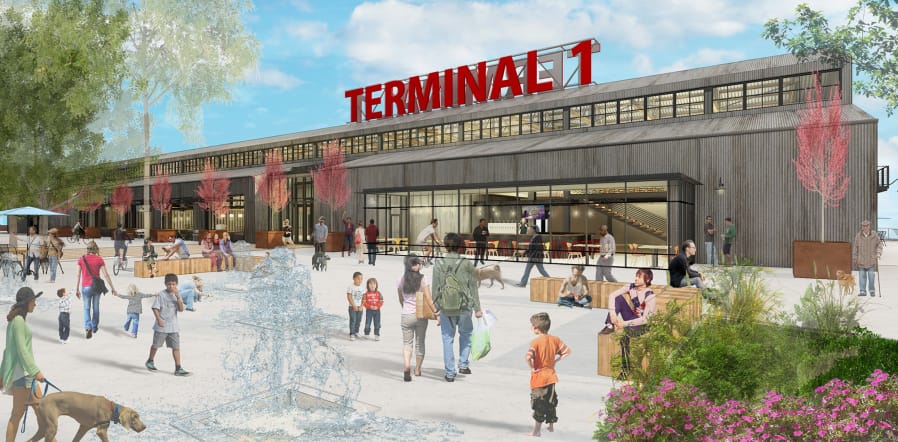The public was offered its first look at initial designs for the future Terminal 1, the Port of Vancouver’s oldest property.
During a workshop after Tuesday’s Port of Vancouver Board of Commissioners meeting, architects working with the port described the vision of transforming Terminal 1 as it becoming a beacon, gateway and front porch of the port, Vancouver and Washington state.
A “north portal” to access the site would have rows of trees, leading across Columbia Way to a kind of central space, complete with perhaps a brewery, a pavilion and a water feature.
The conceptual drawings reimagine the 10-acre site with a larger, airier market building that pays homage to the location’s history as the port’s original warehouse, built atop a new pier. But the port’s vision aims to get people out of their cars and on their feet, exploring the property.
In this version of the future, gone are the former Red Lion Hotel Vancouver at the Quay. In its place is a new public market echoing that of Seattle’s Pike Place Market or Vancouver, B.C.’s Granville Station.
With “Terminal 1” spelled out atop the roof, the new building would be wrapped in corrugated metal, with large glass windows and garage doors that allow people and businesses to spill into the walkway.
The bottom floor of the proposed market building would have about 30,000 square feet with a few anchor tenants and a number of stalls that serve as incubator spaces for vendors and invite people to meander.
The dumbbell-shaped 10,000-square-foot mezzanine level would have more open space and a commercial kitchen and possibly restaurants.
Linger, meander
Architects from Seattle-based Graham Baba proposed putting solar panels on the roof, big windows for lighting and using the river as a heat source and heat sink for the building’s HVAC system.
The size of the new building and the condition of the pier below means the port cannot preserve the original structure as proposed. Instead, the conceptual designs incorporate the large framing timbers salvaged from the original building into the new structure.
The space around the building is designed for people to linger and meander from space to space. The Waterfront Renaissance Trail bisects the property, traveling across a small bridge over a stormwater garden at the water’s edge. It then cuts in front of the market building and passes open space and a viewing garden where the port’s amphitheater currently stands.
Port Commissioner Eric LaBrant said he’d heard members of the public wonder how the new market space would interact with the city’s existing farmers market.
“This makes it easy to see that they’re completely different things with their own unique character,” he said.
The conceptual designs didn’t resolve parking at the site. With the exception of service vehicles, cars and trucks will be kept out of the central space.
Estimates from earlier this year put the cost of replacing the Terminal 1 dock at around $30 million. The costs of further developing the site are still unknown.
The project is approaching the 30 percent design phase.
With the port commission’s blessing of the preferred alternative at Tuesday’s workshop, the port will soon develop refined design, funding strategy and construction timelines for the project.
Port of Vancouver spokeswoman Abbi Russell said that is an issue the port is resolving with its waterfront neighbor Gramor Development and the city of Vancouver.
“A solution is coming,” she said.





